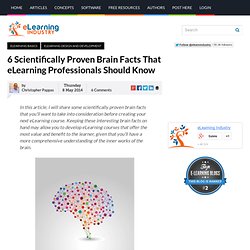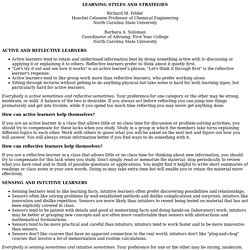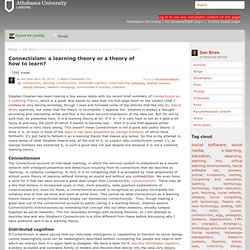

Connected Learning: The Power Of Social Learning Models. Connected Learning: The Power Of Social Learning Models by TeachThought Staff Ed Note: This post was revised and republished from a previous post in 2012.

DML (a “Digital Media and Learning” project), believes in the “the power of participation,” and they’ve created a learning model overview to share their thinking. We recently published our Inside-Out Learning model, an attempt to return the learning to the families, organizations, and communities authentic to the learner. DML’s model is similar in philosophy, underscoring the role of interdependence. Connected Learning “is an answer to three key shifts as society evolves from the industrial age of the 20th century and its one-size-fits-all factory approach to educating youth to a 21st century networked society.” Welcome to CCK11 ~ CCK11. Connectivism: Learning theory of the future or vestige of the past?
The Connectivist Learning Environment. Brainteasers and College Readiness. "Hey there!

You like knock-knock jokes right? Ok, I got a great one for you. Here it goes. Ready? You start... " I know that is how I felt when I went to college for the first time. Daniel Willingham, a cognitive scientist, wrote one of my favorite books, Why Don't Students Like School? It is ironic that there is such a push for higher thinking in school, but our brains were not made for thinking, they were made for remembering.
Many of us love to do puzzles, Sudoku, crosswords, jigsaws, and the twisted nail things but can't figure out how to program the TV. Here, try this one (my favorite brainteasers are also the simplest): What goes up the chimney down, but not down the chimney up? The thing that I was most unprepared for at college was the idea that I had to come up with the ideas (knock-knock...). In my book, Teaching Students to Dig Deeper, I listed ten college readiness traits that I wish I had when I went to college. Steven Johnson: Where good ideas come from. Rhizomatic Learning – Why we teach? It’s my week at #change11.

My topic? Rhizomatic Learning. Rhizomatic learning is a way of thinking about learning based on ideas described by Gilles Deleuze and Felix Guattari in a thousand plateaus. A rhizome, sometimes called a creeping rootstalk, is a stem of a plant that sends out roots and shoots as it spreads. It is an image used by D&G to describe the way that ideas are multiple, interconnected and self-relicating. E-Learning and Constructivism. Learning Theories of Instructional Design. Learning Theories. Gagne's Nine Levels of Learning - Team Management Training From MindTools. Training Your Team Effectively Use this tool to structure and deliver training effectively. © iStockphoto/SchulteProductions Have you ever trained someone on a new process or skill?

Perhaps you thought it would be an easy, straightforward task. But once you actually started the session, it may have been harder than you expected. Everyone has different learning styles . Gagne's Nine Levels of Learning provide a step-by-step approach that can help managers, trainers, and facilitators structure their training so that their students or teams get the most from their learning opportunities. In this article, we'll examine Gagne's Nine Levels of Learning, and we'll review how to apply this tool when training your team. Motivation at a Glance: An ISchool Collaborative. The goal of Motivation at a Glance is to document theories of motivation, particularly those theories which address learning, education, and information processing, in an effort to identify common threads and concepts which together provide a robust picture and insight into the factors which arouse our desires and influence our behaviors.

Edward L. Deci addresses these factors in his book, Why We Do What We Do: Understanding Motivation (1995). Daniel Pink tackles the question in, Drive: The Surprising Truth About What Motivates Us (2009). The insights shared by Mr. Pink are based on the work of Deci and Ryan's Self-Determination Theory.An effort to find common threads among theories of motivation, is addressed by Piers Steel, in Integrating Theories of Motivation (2006), "...our understanding of behavior has been hindered by the very extent of our efforts. PROJECT BACKGROUNDThis project began as an independent study with Dr. PAGE REFERENCES Alexander, P, & Zimmerman, B. (2000). 6 Scientifically Proven Brain Facts That eLearning Professionals Should Know. In this article, I will share some scientifically proven brain facts that you'll want to take into consideration before creating your next eLearning course.

Keeping these interesting brain facts on hand may allow you to develop eLearning courses that offer the most value and benefit to the learner, given that you'll have a more comprehensive understanding of the inner works of the brain. While the content, layout, and navigability of your eLearning course are important; determining how a learner's brain actually acquires and retains information is an essential aspect of eLearning design and development. Without a firm grasp of how the brain works and the processes involved in learning new concepts, ideas, and skill sets, even the most experienced Instructional Designer will be unable to develop an effective eLearning course. Our brains do not have the capacity to multitask.For years, multitasking has been considered an all-important skill.
Felder & Soloman: Learning Styles and Strategies. Richard M.

Felder Hoechst Celanese Professor of Chemical Engineering North Carolina State University Barbara A. Soloman Coordinator of Advising, First Year College North Carolina State University Active learners tend to retain and understand information best by doing something active with it--discussing or applying it or explaining it to others. Index of Learning Styles Questionnaire. Educational-origami - home. Connectivism: a learning theory or a theory of how to learn? Stephen Downes has been making a few waves lately with his recent brief summary of Connectivism as a Learning Theory, which is a great deal easier to read than his 616-page book on the subject (that I confess to only having skimmed, though I read and followed some of the articles that fed into it).

David Wiley approves, but notes that the theory is incomplete. I approve too. Stephen is always a thought-provoking and interesting writer and this is his most succinct expression of the idea yet. Õppimine.